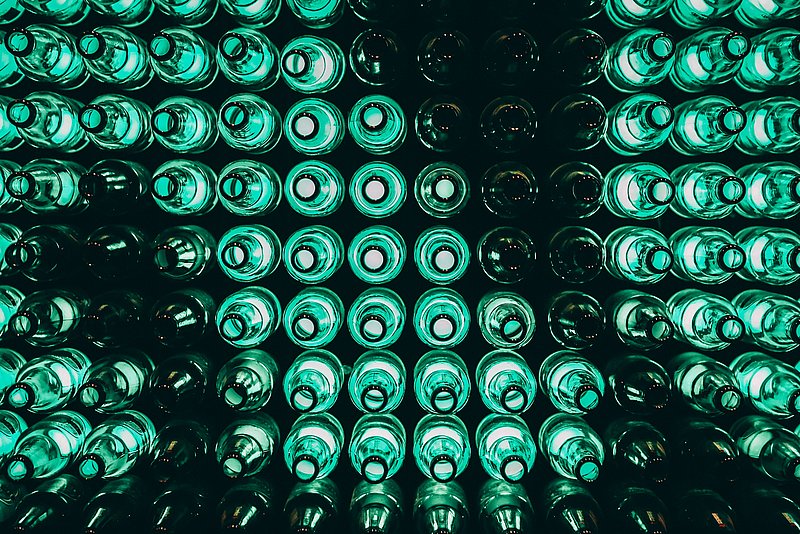What’s Better: Glass Bottles Or Plastic Bottles?
Those who think sustainably usually prefer reusable bottles. Since they can be used several times, they are considered to be more environmentally friendly. This is especially true for glass bottles. Those are not made from petroleum and can be cleaned more often. But are plastic bottles really less sustainable?
The proportion of reusables in Germany, one of our partner countries, has been falling continuously for years. This is due, among other things, to the range and supply of discounters: Reusable systems require space for the storage of boxes and discounters cannot or do not want to grant this. In addition, there is a fundamental rethink in society. For decades, the deposit bottle was considered high-quality and useful. Today, however, even short-lived bottles became part of the deposit system and have thus experienced an appreciation in the eyes of consumers. After all, the deposit is even higher. Significantly more PET bottles are sold than glass bottles because the disposable plastic bottle is joined by the reusable plastic bottle. But, unlike its disposable relatives, it has advantages.
The plastic reusable bottle: light and practical
A reusable PET bottle can be refilled about 20 times. It is stable and hygienic. It weighs less than a glass bottle, which is why its transport requires less energy. Therefore, less CO2 is emitted. If it is damaged after many cleaning operations, it can be recycled. Usually no new beverage bottles are produced from the PET recyclate as this processing is not particularly efficient. The raw material is often used for clothing, various plastic products and also for fibers in industry.
The glass reusable bottle: durable, but heavy
A reusable glass bottle lasts twice as long as a reusable plastic bottle. Only after about 50 cleanings the bottle will be recycled. Then, an old glass bottle can become a new one. That sounds like a victory for the glass bottle over the plastic bottle. But beverage containers made of glass also have a weakness: they are comparatively heavy and require more energy during transport and production.
Transport routes – an underestimated factor
If we are really looking for the most sustainable beverage packaging, we have to think about transport. In the end, the transportation distance of any bottle is the decisive factor. The further a drink needs to be transported, the more important the weight of its packaging becomes. As a result, glass bottles with drinks from the region are more sustainable than plastic bottles with drinks from a distance. If it really has to be a remotely produced or even imported drink, the plastic bottle shows its weight advantage.
A rising problem: The individual bottle
Just a few years ago, there were mainly three types of beer bottles in Germany: the slim, the thick and the small bottle. In times of declining beer consumption, manufacturers need to come up with new ideas over and over again in order to boost sales. The individual bottle is one of those ideas. Peculiarly shaped bottles in retro design look like authentic products of small manufacturers and are unmistakable. They are well received by consumers – but they have a major disadvantage. They cannot be universally cleaned and reused and therefore have to travel longer distances.
What about disposable bottles?
Disposable bottles are partly recycled. But we need to consider that recycling is energy-consuming. This applies to both glass and plastic bottles. Therefore, it is all too logical to delay recycling as long as possible. This applies to all the things we own in general – the longevity of any product is crucial for a more sustainable consumerism. However, disposable bottles are extremely short-lived. Even if recycled material is used for the disposable bottle (which is by no means predominantly the case), its life-cycle assessment is significantly worse than that of the reusable bottle. In addition to that, the aspect of transportation comes into plays again: The Environmental Action Germany (DUH) has found that disposable bottles are transported almost twice as far as they are offered throughout supermarkets and discounters in Germany. The DUH's verdict on disposable bottles is devastating overall. The resource requirement of energy and water of reusable bottles is out of proportion in comparison to the use of petroleum for new disposable bottles, making a reusable alternative the more ecological choice.
So.. What’s better?
Pros and cons of reusable glass bottles
+ durable (fillable up to 50 times)
+ easy to recycle
- due to the high weight energy-intensive for long transports between filling and sale
- for individually designed bottles long transports are often necessary
Pros and cons of reusable plastic bottles
+ lightweight and energy-saving in transport
+ easy to recycle
- less durable than glass bottles (up to 25 times fillable)
- PET requires fossil resources, recycling to new bottles not efficient enough
As of today, disposable bottles made of glass or PET are not an ecological alternative. Focusing on the two reusable bottles, the transport route makes the difference. Regional shopping is therefore highly recommended. By the way: Completely out of competition is the combination of tap water and a reusable bottle that can last a lifetime. Not only does this save transport to the store and the trip to the beverage market, but also the production of countless bottles. For tap water to be an alternative, access to clean water is a required necessity. Learn more about the accessibility of clean drinking water and its effects on plastic pollution in this blogpost.


